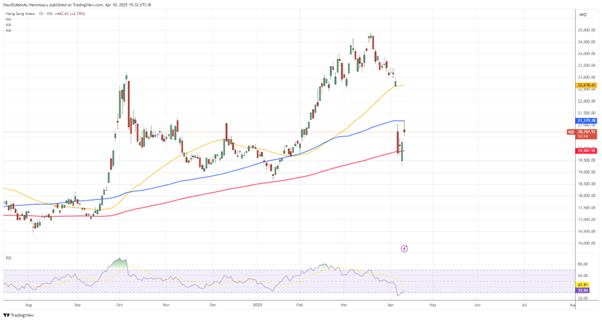Relief rally or pause before the next storm?

Financial markets have just experienced one of the sharpest sentiment reversals in years. A 90‑day pause on the newly introduced “reciprocal” U.S. tariffs for most trading partners sparked a dramatic bounce in global equities, while bonds, currencies and commodities scrambled to find a new equilibrium. Below is a concise walk‑through of what changed overnight, why it matters, and the signposts to watch in the hours ahead.
Washington’s tariff pivot: What actually changed?
Pause, not reversal: After higher duties on 56 nations took effect at midnight, the White House rolled them back to the prior 10 % “baseline” for everyone except China. China now faces a 125 % levy, up from the 104 % announced only days earlier.
Market reaction: U.S. equities staged their biggest single‑day gain since 2008; the S&P 500 jumped 9.5 % and the Nasdaq 100 soared 12 %. Two‑year Treasury yields briefly topped 4 % as traders reassessed the odds of near‑term Fed cuts.

Why the U‑turn? Surging long‑bond yields, heavy equity selling and urgent phone calls from CEOs and lawmakers convinced the administration that a blanket tariff shock risked tipping the economy toward recession.

Europe breathes, but only for now
Futures rebound: Euro Stoxx 50 futures rose almost 8 % in early London trade, while DAX contracts followed suit. The move halts a five‑session, double‑digit slide that had wiped out all of Europe’s Q1 gains.

Underlying tension: The 90‑day window eases immediate pressure, yet a 10 % blanket tariff on EU goods still applies and negotiations remain undefined. Risk premia are likely to stay elevated until clearer rules of engagement emerge.
Beijing’s counter‑playbook
Retaliatory tariffs: China answered with an 84 % duty on U.S. imports, effective today.
Emergency policy meetings: Top Chinese leaders meet Thursday to discuss a stimulus package targeting housing, consumer demand and technology investment. Authorities are also prepared to let the yuan weaken in an “orderly” fashion to support exporters.

Growth downgrades: Several global banks have already trimmed 2025–26 Chinese GDP forecasts by half a percentage point or more, citing diminished export prospects.
Fixed‑income whiplash
Volatility spike: The 10‑year Treasury yield logged its biggest three‑day rise since 2001 before the tariff pause cooled the move. Liquidity in off‑the‑run issues remains thin, and swap spreads in the long end are still deeply negative—warning signs that funding markets are not yet “normal.”
Fed watch: Minutes and recent remarks signal policymakers will not rush to cut unless conditions deteriorate markedly. Traders now price fewer than two quarter‑point cuts for 2025, down from four earlier this week. (No analyst quotes—Fed statements only.)
What to watch next
|
Timeline |
Key Focus |
Market Sensitivity |
|
Next 48 hrs |
Beijing’s stimulus details; PBoC guidance on yuan fix |
CNY crosses, AUD/NZD, Asian equities |
|
Mid‑April |
U.S.–partner “fast‑track” tariff talks begin |
EMFX, industrial metals |
|
Late June |
90‑day tariff pause expires |
Global equity volatility, safe‑haven flows |
|
Q2 earnings |
Cost‑pass‑through evidence (multinationals vs. purely domestic) |
Sector rotation, margin outlook |
Bottom line for investors
Relief ≠ Resolution: A headline‑driven rebound is not the same as policy clarity. The core shift toward protectionism—and the uncertainty it generates—remains intact.
China’s stimulus cushion: Extra spending and a weaker yuan could limit downside for Asia‑centric supply chains, but global demand leakage is unavoidable if tariffs stay.
Stay nimble: Elevated cross‑asset volatility argues for maintaining higher liquidity buffers, focusing on balance‑sheet strength and avoiding over‑exposure to single policy outcomes.
We will continue to track negotiations, central‑bank signals and market technicals to keep you positioned ahead of the next inflection point.
Prepared by Nour Hammoury, Chief Market Analyst at SquaredFinancial
Nour is an investor, independent market strategist, and financial advisor. He holds a BA in Finance and Banking Science from Al-Ahliyya Amman University and a CFTe in Economics from the International Federation of Technical Analysts. He has more than 15 years of experience in forex, stocks, and global economic developments, as well as central bank policies and intermarket analysis. He appears regularly on major international TV networks, such as BBC, Al-Jazeera, Al Hurra, CNBC, and Bloomberg, holding open discussions and sharing insights and readings of the markets and trends.
Disclaimer
This is a marketing communication and does not contain, and should not be construed as containing, investment advice or an investment recommendation or, an offer of or solicitation for any transactions in financial instruments. Past performance is not a guarantee of or prediction of future performance. The information contained herein does not constitute a personal recommendation and does not consider your personal investment objectives, investment strategies, financial situation or needs. Squared Financial makes no representation and assumes no liability as to the accuracy or completeness of the information provided, or any loss arising from any investment based on a recommendation, forecast, or other information supplied by Squared Financial.
The information on this site is not intended for any person in any country or jurisdiction where such distribution or use would be contrary to local law or regulation.